Abstract
In this contribution, the authors evaluate the possibility of using separated access points for power and data transfer in a coupled Wireless Power Transfer-Powerline Communication system. Such a system has been previously proposed by the authors for specific applications, in which Wireless Power Transfer (WPT) should take place in a system where data are transmitted over the power grid. In previous works the authors have performed lab tests on a two coils WPT system equipped with a set of filters to also allow an efficient data transfer. When a multiple coil WPT system is chosen, additional possibilities arise: the access point for power and data can be differentiated, with the aim of maintaining the designed power efficiency and increase data transfer capacity. In this study a four coils WPT system is thoroughly analyzed, modelled, implemented and measured, and a set of guidelines for the correct design (in terms of performance optimization) of the data transfer is given.
1. Introduction
Wireless Power Transfer (WPT) technology has lately gained increasing attention as an alternative way to transmit power with respect to a cabled connection, see for instance [1,2,3]. In particular, applications for small portable consumer electronic devices are already available on the market (i.e., cellular phones, electric tooth brushes and the Qi standard, etc.) while high power applications are still the object of research, study and prototyping (charging of electric vehicles or hybrid vehicles is an example). In the last decade, Power Line Communication (PLC) has been recognised as a viable option for broadband communications, and it can compete with other, and more diffused, technologies when operating in specific environments. PLC technology uses power cables to transmit high speed data; in fact it uses the power grid, that is designed to carry voltages and currents at the mains frequency (typically at 50/60 Hz) to transmit data at much higher frequencies, that are now up to a tenth of MHz, in the most common commercial products. Domestic applications of PLC technology are quite widely diffused, while, on a larger scale, PLC communication is now considered one of the main possibilities to transmit data in a smart grid environment (when, for instance, long distances do not allow wireless data transmission). Recently, the PLC technology has been proposed to substitute part of the cable harness in electric vehicles [4,5,6]. These two technologies are apparently colliding, since WPT transfers power wirelessly while PLC transmits data on a cabled connection originally designed for power. This has led the authors to the idea that a full integration between WPT and PLC could be a solution allowing the use of WPT without the need for changes to a pre-existing PLC system. In [7] a feasibility study of such a system is proposed, in which a preliminary logic outline of the whole system is shown, and the evaluation of the available channel capacity is performed based on a typical four-coils system. In [8], an optimization procedure performed on the lumped equivalent circuit is presented, showing that such a system can be properly designed taking into account both power and data transmission requirements. In addition, in [9] the full system (with coils and filters) was designed and built showing the actual feasibility of the proposal; in particular, ref. [9] is specifically referring to a two-coils WPT system.
In this contribution the authors investigate for the first time the possibility of using the loops and the coils (respectively called also “outer coils” and “inner coils”) of a four coils system as different access points: while the power generator and load are respectively connected to the drive and load loop, the data modems are now connected between the coils. This completely new concept, under specific circumstances, can guarantee a wider communication band, hence better communication performances.
In [9], the two coils system has been designed to transmit power at the resonant frequency of MHz, that is often related to low power applications such as energy harvesting devices etc., see for instance [10]. In this paper the system is designed to transmit power at a frequency of hundreds of kHz, typical of high power applications such as battery charging of electric vehicles, as shown in [11]. In addition, the frequency range considered in this paper is typical of narrow band (NB) PLC, in contrast to broad band PLC that uses tens of MHz. Then, this work shows for the first time that NB-PLC and WPT can coexist and share the same medium. The proposed system is of great potential and can be the key point in which both data and power should be transferred, for instance in a Battery Management System for electric vehicles [12] or in domestic applications [13]. The paper is organized as follows: in Section 2 the rationale behind the main idea is described; in Section 3 it is described how the system has been built according to analytical relations; in Section 4 the theoretical analysis relative to the optimal relation between resonant frequency, distance and load is obtained, while Section 5 presents the analytical and theoretical results for the proposed system.
2. WPT System with Multiple Data Access
Figure 1 shows the typical equivalent circuit of the non radiative four coils WPT system with the so called drive and load loops (where the source and the load are connected) and the transmitting and receiving coils, that are basically used as repeaters in order to increase the power transmission distance (reducing ) retaining maximum power transfer. The inductances and represent the transmitting and receiving coils, while and represent the drive loop and load loop inductors respectively. The resistances represent the winding resistances of the corresponding inductor and are, as a matter of fact, parasitic elements. The mutual inductance represents the coupling between the inductors and (with coupling coefficient ), while the capacitors are designed to resonate with the corresponding inductor at the resonance frequency. The coupling factor depends on the distance between the transmitting and receiving coils, which is a fundamental design parameter. In this scheme, parasitic capacitances (basically given by the turn to turn capacitance of each inductor) are not represented, since they are grouped together with the capacitances (of each inductor). Usually the transmitting and receiving coil (also called “inner coils” due to the fact that are represented in between the other two inductors) have no access point and are often mounted on the same equipment as the relative loop.
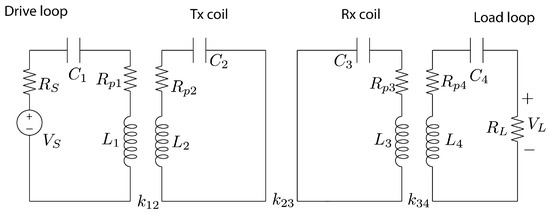
Figure 1.
Four coils lumped equivalent circuit.
The use of a lumped equivalent circuit to represent a WPT system is a common way to understand and design it; speaking of frequencies in the range of kHz to few MHz, we are in the field of non radiative WPT systems, and this approach will be used throughout the paper.
When additional data transfer capabilities (with the motivation of interfacing to a PLC system) have been added to the WPT system, the most logical approach was to use the same terminals of the power transfer: this is trivial for a two-coils system, and was the first choice for a four-coils system ([7,8,9]).
A first theoretical study regarding the use of different access points for four-coils WPT systems has been performed in [14]: two different circuits have been analyzed as shown in Figure 2 and Figure 3. The circuit of Figure 1 has been modified in order to include additional filters that are actually required in the proposed combined system WPT-PLC: they should prevent power from flowing through the PLC modem (to avoid damages) and guarantee optimal coupling between the modem and the WPT system, possibly not affecting the power channel in terms of efficiency.

Figure 2.
Power and data from the outer coils, with the inclusion of the parallel filter.
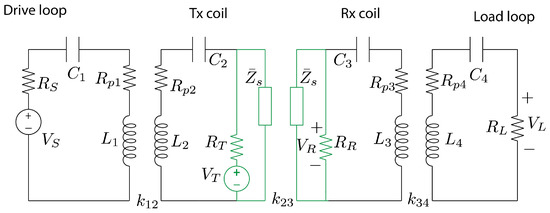
Figure 3.
Data from the inner coils, with the inclusion of the series filter.
The system in Figure 2 is basically the one described in [9], with the parallel resonant circuit that resonates at the frequency of the power signal, hence operating as an open circuit. In this way the power signal (generated by and received by ) does not flow into the PLC modem . On the contrary, the wideband data signal generated by and received by is not affected by the higher magnitude power signal.
Figure 3 shows the new architecture object of this theoretical and practical study: data communication is performed between the inner coils, with the addition of the series resonant circuit; this series LC filter behaves as a short circuit at the power frequency, basically eliminating from the inner loops the modem and the transmitting and receiving loads (respectively , ,): in this way the power signal does not flow through the PLC modem and it is not dissipated into the receiving and transmitting resistances. At frequencies different from , data signal can flow between the inner coils.
In this paper the authors have considered, for the sake of simplicity, second order parallel or series LC resonant circuits resonating at the power frequency . Despite the simplicity of this approach, the results obtained clearly indicate that good performances can be achieved. Given the equivalent circuits shown above, it is possible to derive the analytical transfer functions both for power and data transfer: Equations (A1) and (A2) are relative to the transfer function of the power channel of the circuit in Figure 2, while (A3) and (A4) are relative to the transfer function of the data channel in the same circuit. In the same way, Equations (A5) and (A6) are relative to the transfer function of the power channel of the circuit in Figure 3, while (A7) and (A8) are relative to transfer function of the data channel in the same circuit. These expressions will be used in Section 5 and compared with experimental results.
In [14] a theoretical analysis has been performed on the two circuits with a specific set of circuit’s parameters values (which were originally given in [15]); these theoretical results show that, in this specific case, the channel capacity in terms of bit rate is higher when data is transmitted between the inner coils. Far from being an exhaustive analysis, these results have led the authors to perform additional investigations and experimental validation, that are reported in this paper.
3. Coil Design
The design of the WPT system has been performed taking into account the working frequencies and coils dimensions, allowing a simple experimental setup. In four coils WPT systems, the loop (e.g., power access point) and the short circuited coil are a unique system in which their mutual distance is kept as constant; in most cases, two twin loop-coil system are used to create a four coils WPT system.
Figure 4 shows the outline of a loop-coils set, in which the dimensions are relative to the coils support and are reported in Table 1.
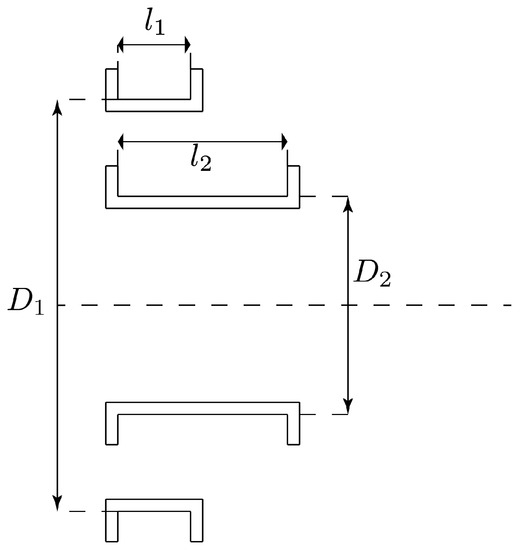
Figure 4.
Axial section of a loop-coil set.

Table 1.
Dimensions of the coils support.
In order to reduce the resistance due to skin and proximity effect, a copper Litz wire has been used: the chosen wire is characterized by 600 strands, each of them having a diameter of mm; considering that skin depth at the frequency MHz is about m, the chosen wire works well for power frequencies of the order of a few MHz. The coils have been realized as single layer coils, whose value of self inductance has been calculated according to [16] and the self capacitance according to [17]; these values are reported in Table 2.

Table 2.
Electrical parameters of the inductors.
The coupling coefficient (hence the mutual inductance) for the configuration shown in Figure 4 has been consequently calculated according to [18], resulting in the following values: H, .
The four coils system is composed by two loop-coil sets facing each other; the coupling coefficient between the two coils have been calculated for distances varying in the range between 3 cm and 23 cm ([18]); some of them are reported in Table 3. It is worth noting that the coupling between loop and coil belonging to different sets (i.e., and ) have been neglected, as it is usually done in such cases. This assumption is justified by analyzing the distance between the left loop and the right coil (considering the dimensions shown in Figure 4) and the results in Table 3: and would be much lower than the other coefficients.

Table 3.
Coupling coefficient of the coils as a function of the distance.
In order to validate the design procedure, the self inductances have been measured with a Vector Network Analyser (VNA) which allows verifying the frequency behavior of the system as well. The measured values of the inductances are H and H showing a good agreement with the design parameters which are listed in Table 2. The AC resistance of the coils were also measured, obtaining m and m. The setup of Figure 4 has been experimentally implemented as depicted in Figure 5 and the two coils have been connected to the two ports of the VNA, measuring the frequency behavior of the scattering parameter (also called transmission coefficient). Figure 6 shows the comparison between measurement and analytical calculations (not reported here for a two coils system for the sake of conciseness): as described, the system realized matches with very good accuracy the design criteria.
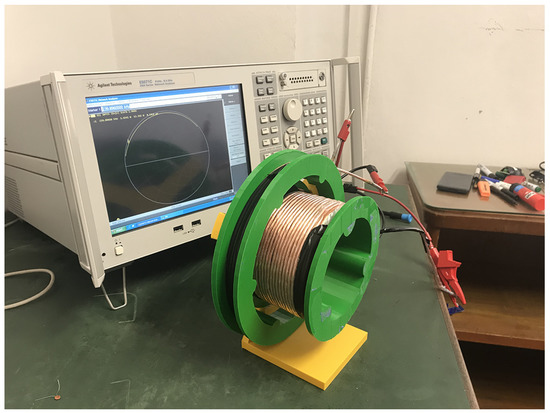
Figure 5.
Experimental characterization and validation of the setup.
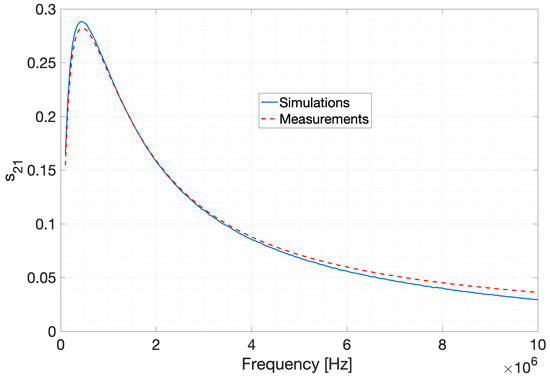
Figure 6.
scattering parameter relative to the coil-loop system.
4. Four-Coils WPT Input Impedance System Modeling
This section focuses on the modeling of a four coils WPT system, in particular we first recall the equations of the circuit, then we derive an exact analytical expression of the input impedance of the four coils system at the resonance frequency. To the authors’ knowledge, the expression of the input impedance so obtained is slightly different with respect to the ones derived in the literature, and it allows to design the WPT system to accomplish maximum power transfer. A four-coils WPT system is shown in Figure 7. The equations using the mesh analysis are as follows:
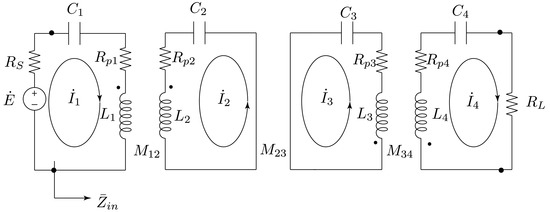
Figure 7.
Four-coils Wireless Power Transfer (WPT) system.
At the resonant angular frequency , considering that , and neglecting the parasitic resistances , equations in (1) become
From Equation (2) it is straightforward to derive the input impedance :
We note that the impedance is real, and it can be written in terms of the coupling coefficients as
Knowing the exact expression of the input impedance at the resonance frequency allows us to design the system in order to achieve maximum power transfer, by placing
It is interesting to compare our result with the one reported in [19], where parallel resonant capacitors were used in the drive loops, and where the maximum power transfer condition was shown to be met if . The latter result was obtained by neglecting the parasitic resistances, as in our case, but also neglecting the parallel capacitor in the transmitting drive loop, which was considered as open circuit. On the contrary, our result is exact, and it allows an optimal matching. Moreover Equations (4) and (5) bring new design guidelines, that highlight a dependence between the optimal resonant frequency and the coupling coefficient :
In order to design the system we used Equation (6), where the only free parameter is as it depends on the distance between coils as shown in Table 3. After having designed, as in the previous section, the coils dimensions and geometries (determining the coupling coefficients , , and the inductances) the next design steps are as follows:
It is noteworthy that the expression shown in 4 is valid for any load, since it is sufficient to substitute the resistance with the load impedance . There are many papers related to the evaluation of the load impedance depending on the power electronics receiving the high frequency a.c. power. The use of a resistive load in this paper does not change the rationale behind the idea and it is an approximation that is generally used.
5. Theoretical and Experimental Results
5.1. Description of the Measurement Setup
The WPT system has been implemented and a measurement campaign has been performed to verify the theoretical results; a photo of the whole system composed by the four coils (assembled in the form of two coil-loop subsystems), the filters and the VNA is shown in Figure 8.
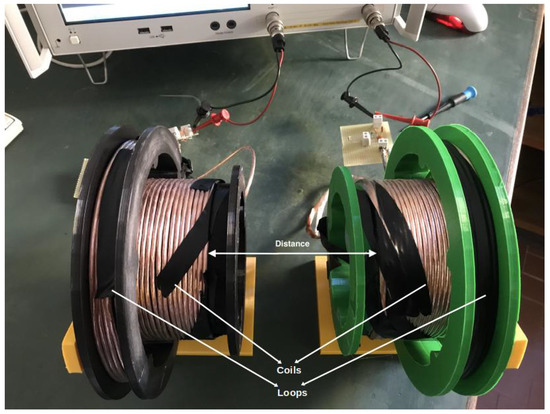
Figure 8.
WPT system during measurement.
The theoretical results showing that the inner coils can be chosen as data access point in order to increase bandwidth are experimentally verified; in particular we realized two test cases for two different distances, namely 5 cm and 15 cm. The corresponding resonant frequencies and capacitors values are shown in Table 4.

Table 4.
Test case configurations.
For each case, the series and parallel filters ( and ) have been realized as ideal second order series or parallel circuits; from the theoretical calculations (with the analytical expressions presented in the Appendix A), we have verified that the proper selection of the data access point is strictly influenced by the filter design; in particular, considering that all the filters must resonate at the chosen frequency , there is a degree of freedom in the choice of the inductor or the capacitor. In order to highlight the different behavior, the authors report here two different choices for each case study:
- (a)
- The filter is constructed with L and C components whose values are coincident to the values of L and C of the inductor it is connected to. For instance, the filter connected to the drive loop 1 having inductance equal to and capacitance is realized with components and ; the same holds for the series filter .
- (b)
- The filter is constructed with L and C components whose values are coincident the values of L and C of the inductor they are not connected to. For instance, the filter connected to the drive loop 1 is realized with components and ; the same holds for the series filter .
As it will be shown later, these two choices lead to different behavior of the data channel. It must be pointed out that the simulation results shown in this section have been obtained using for , , and the measured values (and not the design values) given in Section 3.
5.2. Case Study 1 (Distance 5 cm)
For Case Study 1, the following table resumes the filter parameters for the subcases (a) and (b); in all the figures reported in this section, the transfer function has been taken as output; when the power channel is considered, in order to obtain the scattering parameter it is sufficient to multiply by 2 the transfer function since the circuit works with the termination resistances of of the VNA, according to
Figure 9 shows the comparison between the analytical calculations and measurements for the power channel in Case Study 1a; in particular Figure 9 is referred to the data access from the outer coils (the system represented in Figure 2), and the values of the filters as reported in Table 5. While from the design results at the resonant frequency the power transfer should achieve an efficiency close to unity (where efficiency is referred to as power transfer efficiency and not frequency efficiency), measurements shows a decrease of about : this is due to the components’ tolerance and parasitic effects. For instance, the parallel filter does not behave exactly as an ideal filter; however, the design frequency is reasonably achieved, together with a good maximum value of .
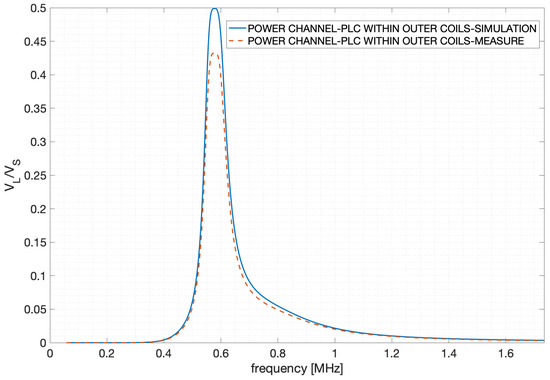
Figure 9.
Transfer functions comparison between measurement and calculations for the power channel, case 1a.

Table 5.
Filter parameters for Case Study 1.
For the same circuit (data between outer coils), a comparison between analytical calculations and measurement have been performed, and shown in Figure 10; in this case we notice again a peak reduction and a slight frequency shifting phenomenon. Both phenomena are due, also in this case, to the tolerances and non-ideality of the components. The selection of higher quality components and a sensitivity study (performed for instance with MonteCarlo analysis as in [9]) could be useful for a more accurate realization of the system.
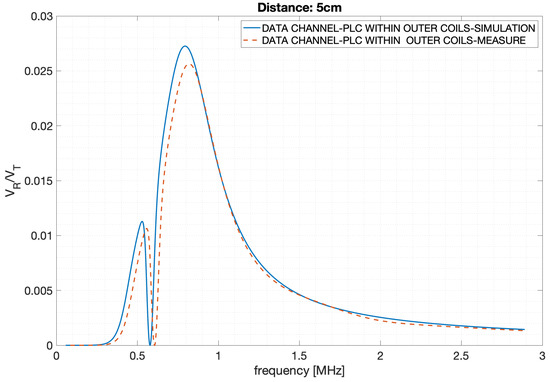
Figure 10.
Transfer Functions comparison between measurement and calculations for the data channel, case 1a.
As shown in the previous figures, the designed system performs as desired; for this reason the following figures only show analytical results.
Figure 11 shows the analytical results relative to the power transfer function for the two circuits (data from inner and outer coils), each of them implemented with the different filters as reported in Table 5, resulting in a total number of simulations equal to four. In particular, Figure 11 shows that using the inner coils for data transfer leads to a slightly narrower power channel with respect to the use of outer coils; in addition, different implementation of the filters can enhance or reduce this behavior.
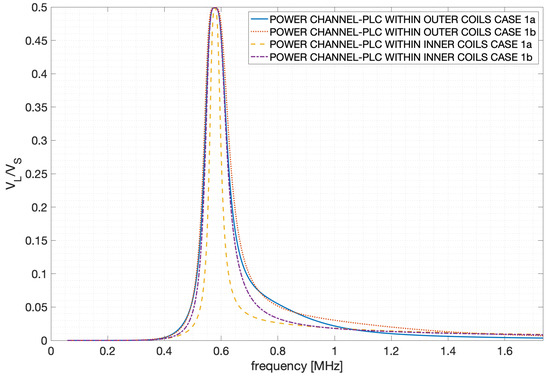
Figure 11.
Transfer function comparison for the power channel, Case Study 1.
Figure 12 shows the analytical results relative to the data transfer function for the two circuits (data from inner and outer coils), each of them implemented with the different filters as reported in Table 5. The different behaviors of the transfer functions relative to the data channel are now extremely evident and it is not only reduced to a slight difference in the bandwidth. In particular, there is a strong effect on the transfer function both of the different data access point and filter realization. In particular, the best performing solution in terms of bandwidth consists in the use of inner coils with the series filters implemented as and , while the worst solution consists in the use of outer coils with the parallel filters implemented as and .
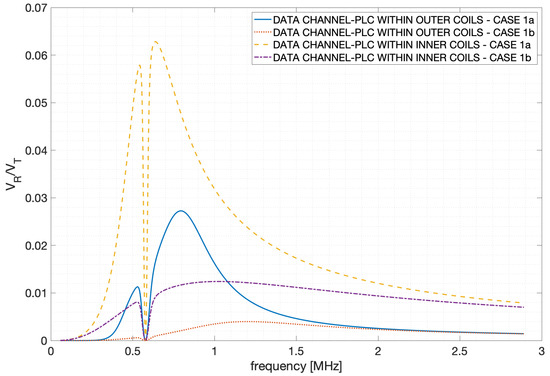
Figure 12.
Transfer function comparison for the data channel, Case Study 1.
This qualitative analysis is validated by the calculation of the channel capacity in the four previous cases. We can refer to the Shannon-Hartley approach: the signal sent from the transmitter is filtered by the channel transfer’s function, which is in general selective and reaches the receiver together with the noise which, in this case, is mainly produced by the signal generator and RF amplifier. The following Shannon-Hartley law can be used:
in which C is the channel capacity in bits per second, B is the bandwidth of the channel, is the signal power spectrum, is the noise power spectrum and f is the frequency. As for the channel capacity objective, the following assumptions are made: both the injected power spectrum , and the noise power spectrum , are frequency independent, and the noise is considered as additive white Gaussian noise at the receiver. The is then defined as , and the received power spectrum can be expressed as a function of the injected power spectrum and the transfer function, according to . Under these assumptions, (8) can be rewritten as
Figure 13 shows the channel capacity in the frequency band , typical of broadband power line. It is evident that reasonable data transmission capacity can be obtained for a 5 cm distance, and that for high signal to noise ratio a speed of above 1Mbit per second can be reached. In addition, as qualitatively seen from the transfer functions, the data communication between inner coils is outperforming other practical solutions.
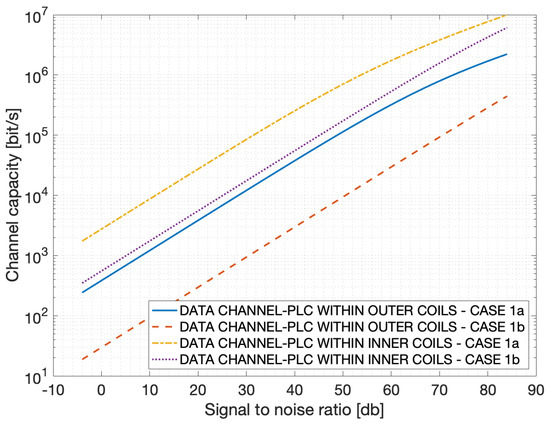
Figure 13.
Channel capacity comparison, Case Study 1.
5.3. Case Study 2 (15 cm Distance)
For the Case Study 2 (15 cm distance), the following table resumes the filter parameters for the subcases (a) and (b) (as a matter of fact, the filters are the same used for Case Study 1).
For the sake of conciseness, relative to Case Study 2, we show the comparison between analytical results and simulation only for the data transfer between outer coils, as reported in Figure 14. In this case we notice again a peak reduction and a slight frequency shifting phenomenon due to components characteristics.
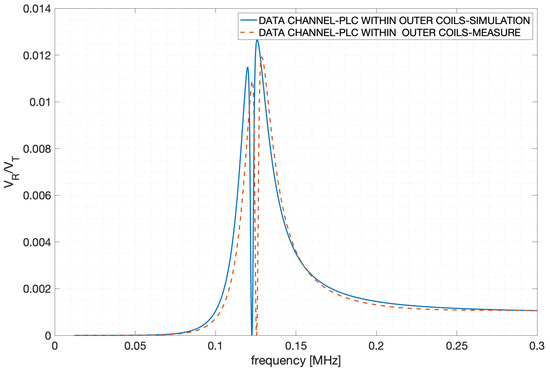
Figure 14.
Transfer function comparison between measurement and calculations for the data channel, case 2a.
Figure 15 shows the analytical results relative to the power transfer function for the two circuits (data from inner and outer coils), each of them implemented with the different filters as reported in Table 6. As happened for Case Study 1, it can be noticed that the use of the inner coils for data transfer leads to a slightly narrower band of the power channel with respect to the use of outer coils. In addition, a reduction of the peak value (transfer efficiency) is observed, and it is due to the increased distance: only in the case of an ideal system without parasitic resistances can maximum transfer () be achieved; in realistic cases at increasing distances there will always be a decreasing efficiency.
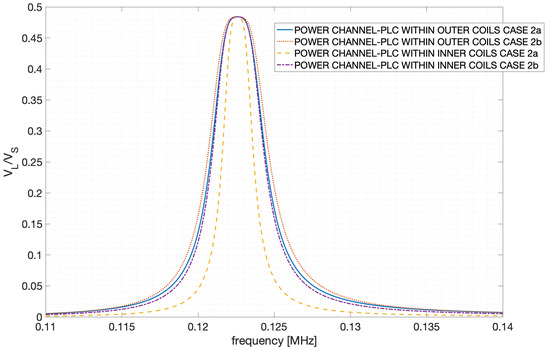
Figure 15.
Transfer function comparison for the power channel, Case Study 2.

Table 6.
Filter parameters for Case Study 2.
Figure 16 shows the analytical results relative to the data transfer function for the two circuits (data from inner and outer coils), each of them implemented with the different filters as reported in Table 6. Looking at the graphs from a qualitative point of view, the two best performing solutions (in terms of bandwidth) seem to be the ones in which data is transferred either between inner or outer coils with the filters (either parallel or series) implemented as in case 2a (i.e., with the filters elements L and C having the same values as the coils’inductance and resonance capacitors). However data with outer coils with filters a) have a narrow bandwidth centred on the notch, giving selectivity that is not suitable for data transmission.
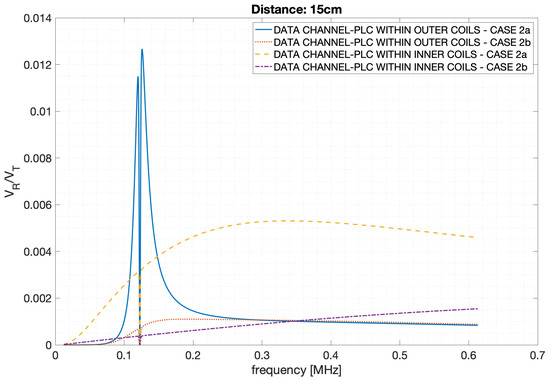
Figure 16.
Transfer function comparison for the data channel, Case Study 2.
Figure 17 shows the channel capacity for Case Study 2. This case study, characterized by a higher distance, shows a lower data transmission capacity if compared to Case Study 1, however the system performances could be more than acceptable depending on the specific application. Also in this case the data transfer between inner coils is outperforming other practical solutions.
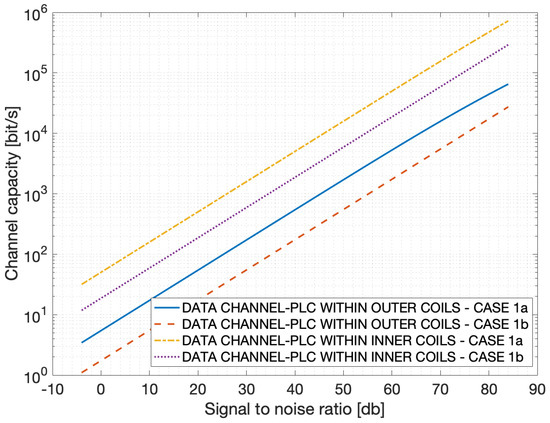
Figure 17.
Channel capacity comparison, Case Study 2.
5.4. Discussion
The measurements and calculations shown before can be used to draw the following considerations relative to the combined system allowing both power and data transfer wirelessly and guaranteeing an efficient interface with a PLC system.
- (a)
- If the power section is properly designed in order to guarantee the desired power at the receiver (i.e., maximum power, maximum energy efficiency or an intermediate situation), the presence of additional filters for data transfer does not affect power at the resonant frequency.
- (b)
- The convenience of using different access points for data and power (data from inner coils) is influenced by the realization of the filters. From our analysis, data access from inner coils is convenient in terms of data bandwidth, provided that the proper series filter on the inner coils is designed.
- (c)
- From our analysis, higher data bandwidth from inner coils (the most convenient approach) results in an increased selectivity of the power channel.
- (d)
- It is known that PLC works well with attenuations that can reach up to −40 db, that corresponds to a voltage gain of . As for the injected power of typical PLC systems, the usual SNR is in the order of 60 db, leading to the more than acceptable capacities shown in the graphs.
Point (a) is valid if the filters’ components are selected with a high accuracy, something that will also prevent frequency shifting that reduces the system’s efficiency, especially thinking about point (c). The consideration of point (b) is valid based on the results obtained using basic filters. The particular choice of the values the L and C filters components has been performed for the sake of simplicity. In basic second order filters, the same resonant frequency can be obtained (theoretically) with an infinite combination of components, and when power is transmitted additional constraints on the components obviously arise. Furthermore, components dimension should also be taken into account in the design process, for instance speaking about higher value inductances.
Higher order filters will be the object of future investigations, since their use should be able to increase the system’s performance, especially from the data transfer point of view. The series and parallel filters discussed in the paper perform the operation that PLC couplers perform in commercial modems, i.e., impedance matching to achieve efficient data transfer and prevent power to damage the modem itself.
Higher order filters are generally used in PLC modems and can be properly designed for this specific system; a sentence regarding higher order filters is already present in Section 5, but it has now been extended.
As a final consideration, the use of different access points for data and power can be of interest when a higher data bandwidth must be achieved, and when galvanic insulation between the power system and data modem is needed. In these cases, the cost of specific filters should be evaluated in order to obtain the desired performances.
6. Conclusions
In this paper the authors show that a combined WPT-PLC system (retaining both the usefulness of transmitting power without electrical contact and the possibility of being included in a power line communication environment) can achieve both power efficiency and high channel capacity. In addition, a multiple coils system (which is used to increase power transmission distance with respect to a two coils system) can be exploited as a multiple access point, reaching higher data transfer capacity. In the paper, the authors analyze and measure different setups, showing that the proper design of the coupling filters is the key point to achieve higher data transfer bandwidth, and in this case different access points can give better results.
Author Contributions
The authors have contributed equally to the theoretical development, measurement and writing of the paper.
Funding
This research was funded by the University of Pisa, Progetti di Ricerca di Ateneo-PRA 2018-19.
Conflicts of Interest
The authors declare no conflict of interest.
Appendix A
Appendix A.1.
The transfer function relative to the power transfer for the system reported in Figure 2 can be calculated as follows; the parallel filter is composed by a parallel connection between an inductor and a capacitor .
with
Appendix A.2.
The transfer function relative to the power transfer for the system reported in Figure 3 is calculated as follows, in which the series filter is composed by a series connection between an inductor and a capacitor .
References
- Kurs, A.; Karalis, A.; Moffatt, R.; Joannopoulos, J.; Fisher, P.; Soljacic, M. Wireless power transfer via strongly coupled magnetic resonances. Science 2007, 317, 83–86. [Google Scholar] [CrossRef] [PubMed]
- Lee, S.H.; Lorenz, R.D. Development and Validation of Model for 95%-Efficiency 220-W Wireless Power Transfer Over a 30-cm Air Gap. IEEE Trans. Ind. Appl. 2011, 47, 2495–2504. [Google Scholar] [CrossRef]
- Madawala, U.K.; Thrimawithana, D.J. A Bidirectional Inductive Power Interface for Electric Vehicles in V2G Systems. IEEE Trans. Ind. Electron. 2011, 56, 4789–4796. [Google Scholar] [CrossRef]
- Barmada, B.; Tucci, M.; Raugi, M.; Maryanka, Y.; Amrani, O. PLC Systems for Electric Vehicles and Smart Grid Applications. In Proceedings of the IEEE International Symposium of Powerline Communications and Its Applications (ISPLC), Johannesburg, South Africa, 24–27 March 2013; pp. 23–28. [Google Scholar]
- Lienard, M.; Carrion, M.; Degardin, V.; Degauque, P. Modeling and Analysis of In-Vehicle Power Line Communication Channels. IEEE Trans. Veh. Technol. 2008, 57, 670–679. [Google Scholar] [CrossRef]
- Mohammadi, M.; Lampe, L.; Lok, M.; Mirabbasi, S.; Mirvakili, M.; Rosales, R.; van Veen, P. Measurement Study and Transmission for In-vehicle Power Line Communication. In Proceedings of the IEEE International Symposium of Powerline Communications and Its Applications (ISPLC), Dresden, Germany, 29 March–1 April 2009; pp. 73–78. [Google Scholar]
- Barmada, S.; Raugi, M.; Tucci, M. Power line communication integrated in a Wireless Power Transfer system: A feasibility study. In Proceedings of the IEEE International Symposium of Powerline Communications and Its Applications (ISPLC), Glasgow, UK, 30 March–2 April 2014; pp. 116–120. [Google Scholar]
- Barmada, S.; Tucci, M. Optimization of a Magnetically Coupled Resonators System for Power Line Communication Integration. In Proceedings of the IEEE Wireless Power Transfer Conference (WPTC), Boulder, CO, USA, 13–15 May 2015; pp. 1–4. [Google Scholar]
- Barmada, S.; Dionigi, M.; Mezzanotte, P.; Tucci, M. Design and Experimental Characterization of a Combined WPT-PLC System. Wirel. Power Transf. 2017, 4, 160–170. [Google Scholar] [CrossRef]
- Lu, Y.; Ma, D.B. Wireless Power Transfer System Architectures for Portable or Implantable Applications. Energies 2016, 9, 1087. [Google Scholar] [CrossRef]
- Wang, Z.; Wei, X.; Dai, H. Design and Control of a 3 kW Wireless Power Transfer System for Electric Vehicles. Energies 2016, 9, 10. [Google Scholar] [CrossRef]
- Ouannes, I.; Nickel, P.; Dostert, K. Cell-wise monitoring of lithium ion batteries for automotive traction applications by using power line communication: Battery modeling and channel characterization. In Proceedings of the IEEE International Symposium of Powerline Communications and Its Applications (ISPLC), Glasgow, UK, 30 March–2 April 2014; pp. 24–29. [Google Scholar]
- Son, Y.; Pulkkinen, T.; Moon, K.; Kim, C. Home Energy Management System Based on Power Line Communication. IEEE Trans. Cons. Electron. 2010, 56, 1380–1386. [Google Scholar] [CrossRef]
- Barmada, S.; Tucci, M. Analysis of Two/Four Coils WPT Systems for Embedded PLC Communications. Appl. Comput. Electromagn. Soc. J. 2018, 33, 1112–1116. [Google Scholar]
- Sample, A.P.; Meyer, D.A.; Smith, J.R. Analysis, Experimental Results and Range Adaptation of Magnetically Coupled Resonators for Wireless Power Transfer. IEEE Trans. Ind. Electron. 2011, 58, 544–554. [Google Scholar] [CrossRef]
- Wheeler, H.A. Simple inductance formulas for radio coils. Proc. Inst. Radio Eng. 1928, 16, 1398–1400. [Google Scholar] [CrossRef]
- Grandi, G.; Kazimierczuk, M.K.; Massarini, A.; Reggiani, U. Stray Capacitances of Single-Layer Solenoid Air-Core Inductors. IEEE Trans. Ind. Appl. 1999, 35, 1162–1168. [Google Scholar] [CrossRef]
- Grover, F.W. Inductance Calculation: Working Formulas and Tables; Dover Publications, Inc.: New York, NY, USA, 1946. [Google Scholar]
- Cheon, S.; Kim, Y.H.; Kang, S.Y.; Lee, M.L.; Lee, J.M.; Zyung, T. Circuit-Model-Based Analysis of a Wireless Energy-Transfer System via Coupled Magnetic Resonances. IEEE Trans. Ind. Electron. 2010, 58, 2906–2914. [Google Scholar] [CrossRef]
© 2019 by the authors. Licensee MDPI, Basel, Switzerland. This article is an open access article distributed under the terms and conditions of the Creative Commons Attribution (CC BY) license (http://creativecommons.org/licenses/by/4.0/).